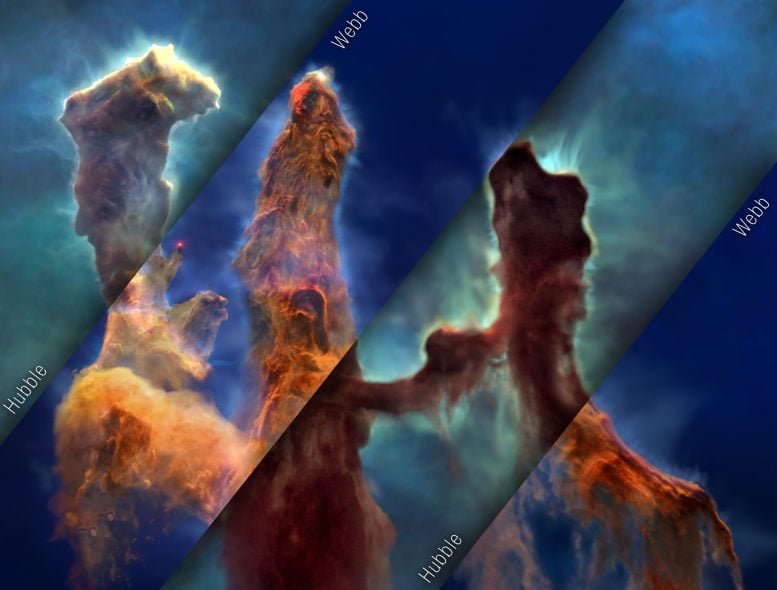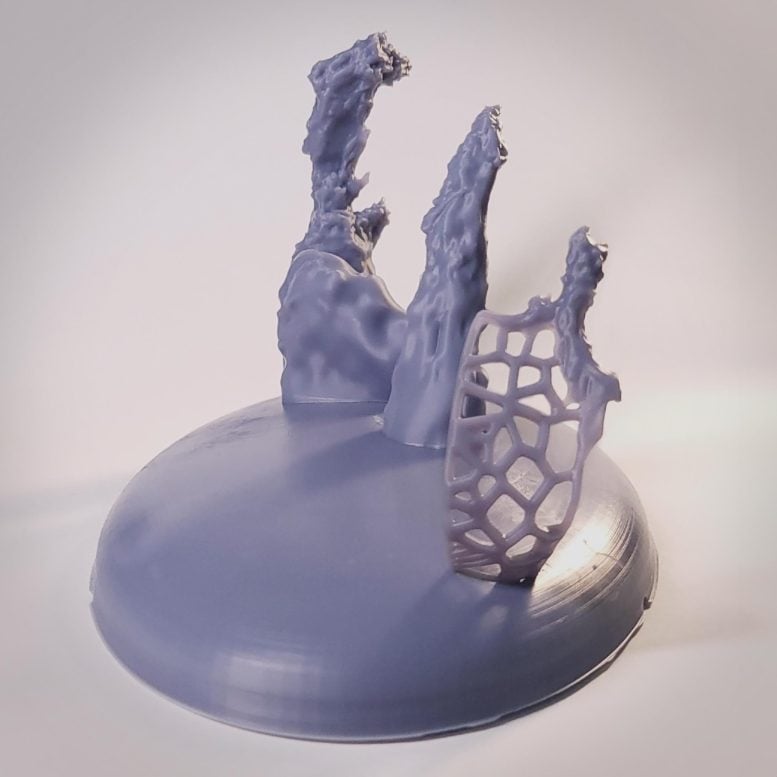
This image is a mosaic of visible-light and infrared-light views of the same frame from the Pillars of Creation. A three-dimensional model of the pillars created for the visualization sequence is shown alternately in the Hubble Space Telescope version (visible light) and the Webb Space Telescope version (infrared light). Credit: Greg Bacon (STScI), Ralph Crawford (STScI), Joseph DePascual (STScI), Leah Hustak (STScI), Christian Nieves (STScI), Joseph Olmsted (STScI), Alyssa Bacon (STScI), Frank Summers (STScI), NASA’s Learning Universe
NASAA new 3D visualization of the „Pillars of Creation” combines data from the Hubble and James Webb Space Telescopes to provide an immersive experience inside these iconic star-making clouds.
Breathtaking new visualizations enable visitors to explore fundamental questions in science, experience how science is done, and discover the universe for themselves.
NASA’s Learning Universe team at the Space Telescope Science Institute (STScI) in Baltimore, Maryland, created a stunning new 3D visualization of the „Pillars of Creation” in the Eagle Nebula by combining data from NASA’s Hubble and James Webb Space Telescopes. This is the most comprehensive, detailed, multi-wavelength movie of these iconic star-forming clouds.
The pillars of the star in new visualizations from NASA’s Hubble and Webb telescopes
Popularized by NASA in 1995 Hubble Space TelescopeThe Pillars of Creation at the heart of the Eagle Nebula have captured imaginations worldwide with their arresting, ethereal beauty.
Now, NASA has released a new 3D visualization of these towering celestial structures using data from NASA’s Hubble and James Webb Space Telescopes. This is the most extensive and detailed multi-wavelength movie of these star-forming clouds.
Insights from multiple wavelengths
„By flying past and between the pillars, visitors experience their three-dimensional structure and see how they differ in the Hubble visible-light view and the Web infrared-light view,” explained Frank Summers, principal visualization scientist at the Space Telescope Science Institute. (STScI) Baltimore, led NASA’s film development team A universe of learning. „This contrast helps them understand that we have more than one space telescope to observe different aspects of the same object.”
The four pillars of creation, composed primarily of cold molecular hydrogen and dust, are being eroded by fierce winds and ultraviolet light from nearby hot, young stars. Finger-like structures larger than the solar system extend from the top of the pillars. Within these fingers, karu nakshatras can be embedded. The tallest pillar stretches three light-years, three-quarters of the distance between our Sun and the next nearest star.
Observational data and scientific accuracy
The film takes the audience to three-dimensional structures of pillars. Rather than an artistic interpretation, the video is based on observational data from a scientific paper led by Anna McLeod, an associate professor at Durham University in the United Kingdom. McLeod also served as scientific advisor on the film project.
“Creative Pillars was always in our minds to create in 3D. Web data combined with Hubble data allowed us to see the pillars more fully,” said Greg Bacon, product lead at STScI. „Understanding the science and how to best represent it allowed our small, talented team to meet the challenge of visualizing this iconic structure.”
Multi-wavelength observations and understanding
The new visualization lets viewers experience how two of the world’s most powerful space telescopes work together to provide a more complex and complete portrait of the pillars. Hubble sees objects that glow at thousands of degrees in visible light. Webb’s infrared vision, which is sensitive to cold objects with temperatures of only hundreds of degrees, pierces through obscure dust to see stars embedded in pillars.
„When we combine observations of different wavelengths of light from NASA’s space telescopes, we expand our understanding of the Universe,” said Mark Clampin, director of the Astrophysics Division at NASA Headquarters in Washington. . Now, with this new visualization, everyone can experience this rich, captivating landscape in a new way.
Bringing space exploration into public learning
Produced by STSCI for NASA with partners at Caltech/IPAC and developed by NASA’s Universe of Learning Astrovis program, the 3D visualization (the first video in this article) is part of a longer, narrated video (the second video in this article) focused on the needs of youth, families, and lifelong learning audiences at NASA’s Astrophysics. Combines science of work and direct contact with scientists. It enables visitors to explore fundamental questions in science, experience how science is done, and discover the universe for themselves.
New developments and educational tools
Several stages of star formation are highlighted in the visualization. As observers approach the central pillar, an embedded, infant protostar at its apex glows bright red in infrared light. Near the top of the left column is the diagonal jet ejected from the newborn star. Although the jet is proof of the star’s birth, viewers cannot see the star itself. Finally, a new star shines at the end of one of the protruding “fingers” of the left pillar.

This photo shows a 3D printed model of the famous pillars in the Eagle Nebula. The 3D sculpted computer model used in the Pillars of Creation visualization was converted to STL file format and mounted on a circular base for use with 3D printers. Credit: Leah Hustock (STScI), Ralph Crawford (STScI), NASA’s Universe of Learning
Expanding public engagement with astronomy
A bonus product of this visualization is new 3D printable model of the pillars of the formation. The basic model of the four pillars used in the visualization has been converted to STL file format so that visitors can download the model file and print it on 3D printers. Exploring the structure of the pillars in this tactile and interactive way adds new perspectives and insights to the overall experience.
Conclusion: Continued education and research
Additional visualizations and interactions between the science of nebulae and learners can be explored through other products produced by NASA’s Universe of Learning. viewspace, a video exhibit currently running in nearly 200 museums and planetariums across the United States. Visitors can go beyond video to explore images produced by space telescopes with interactive tools now available to museums and planetariums.
Based on work supported by NASA under award number NNX16AC65A to the Space Telescope Science Institute in collaboration with NASA’s Learning Cosmic Objects, Caltech/IPAC, Pasadena, California, Center for Astrophysics. Harvard & Smithsonian, Cambridge, Massachusetts and Jet Propulsion Laboratory, La Cañada Flintridge, California.
The Hubble Space Telescope, launched in 1990, is one of the most important instruments in the history of astronomy. Orbiting Earth from about 547 kilometers up, Hubble has revolutionized our understanding of the universe with an extraordinarily clear and deep view of the universe, unimpeded by Earth’s atmosphere. For decades, it has provided invaluable data and stunning images that have led to major discoveries in various areas of astrophysics, including the expansion rate of the universe, the existence of dark matter, and the properties of exoplanets. Unlike ground-based telescopes, Hubble can capture high-resolution images in ultraviolet, visible and near-infrared light, providing detailed views of celestial objects and phenomena that have transformed scientific knowledge and public interest in space exploration.
The The James Webb Space Telescope (JWST), launched on December 25, 2021, marks the next big leap in space observatories. Located nearly 1.5 million kilometers from Earth, the web is designed to observe the universe primarily in the infrared spectrum. big bang. This ability enables astronomers to study the formation of galaxies, stars and planetary systems. Compared to its predecessor, the Hubble Space Telescope, Webb’s suite of sophisticated instruments and large primary mirror provide unprecedented resolution and sensitivity, ideal for probing the atmospheres of exoplanets and detecting signs of possible life. The telescope’s unique position at the second Lagrange point (L2) shields it from the light and heat of the Sun and Earth, ensuring that it can observe the universe with minimal interference.
NASA’s Universe of Learning is an integrated astronomy learning and education program that provides resources and experiences to help visitors understand the universe while connecting them to the science and technology of NASA’s astrophysical missions. Through a collaboration between NASA’s Science Mission Directorate, the Space Telescope Science Institute, IPAC/Caltech, the Jet Propulsion Laboratory, and the Smithsonian Astrophysical Observatory, the program offers a variety of materials, including exhibits, interactive simulations, and educational activities. These resources are designed to engage people of all ages in the process of scientific discovery, inspire the next generation of astronomers, and advance public understanding of the universe.

„Oddany rozwiązywacz problemów. Przyjazny hipsterom praktykant bekonu. Miłośnik kawy. Nieuleczalny introwertyk. Student.
